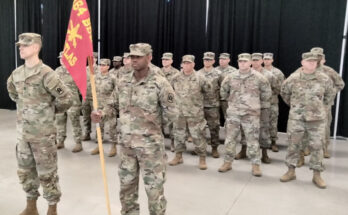United States Infantry Branch Recruitment: The United States Infantry, often referred to as the backbone of the Army, plays a critical role in the nation’s defense.
With its rich history and commitment to the protection of the nation, the Infantry continues to draw thousands of patriotic Americans every year.
In this comprehensive guide, we delve deep into the United States Infantry Branch Recruitment Programs, offering a clear perspective for aspiring soldiers.
Key Components of United States Infantry Branch Recruitment Programs
In the United States Infantry Branch recruitment programs, several key components play a crucial role in attracting qualified individuals to join the ranks. These components are designed to ensure that recruits meet the necessary criteria and undergo comprehensive training. Let’s explore these vital aspects in detail.
A. Outreach and Awareness Campaigns
- Online Presence: The U.S. Infantry Branch maintains a strong online presence through informative websites and social media platforms. This online accessibility allows potential recruits to gather essential information conveniently.
- Social Media Engagement: Active engagement on various social media channels keeps the public informed about the Infantry Branch’s activities, values, and opportunities. This fosters a sense of community and belonging among prospective recruits.
- Advertising and Marketing Strategies: Strategic advertising and marketing campaigns showcase the benefits of joining the Infantry Branch, highlighting the exciting career prospects and the chance to serve one’s country.
B. Eligibility and Requirements
- Age, Citizenship, and Education Criteria: To be eligible, candidates must meet specific age requirements, possess U.S. citizenship, and meet educational prerequisites. This ensures that recruits have a strong foundation for their military career.
- Physical Fitness Standards: Meeting rigorous physical fitness standards is essential. Recruits must demonstrate the physical stamina and endurance required for infantry duties, ensuring they can perform effectively in demanding situations.
- Background Checks and Security Clearance: Thorough background checks and security clearance procedures are in place to maintain the integrity and security of the Infantry Branch. This guarantees that recruits have a clean record and can be entrusted with sensitive responsibilities.
C. Application and Selection Process
- Online Application: The online application process simplifies the initial recruitment phase, allowing candidates to submit their information and express their interest in joining the Infantry Branch.
- Testing and Evaluation: Rigorous testing and evaluation procedures assess candidates’ cognitive abilities, problem-solving skills, and suitability for infantry roles. This step ensures that only the most qualified individuals progress in the recruitment process.
- Interview and Assessment: Personal interviews and assessments provide an opportunity for recruiters to evaluate a candidate’s character, determination, and potential to excel in infantry positions. This holistic approach helps identify the best candidates for training.
D. Training and Development
- Basic Combat Training: Recruits undergo intensive basic combat training that instills core military skills, discipline, and teamwork. This foundation is essential for success in the infantry.
- Advanced Infantry Training: After completing basic training, recruits move on to advanced infantry training, where they acquire specialized skills and knowledge tailored to infantry operations.
- Ongoing Professional Development: The Infantry Branch prioritizes continuous learning and professional development, offering a range of opportunities for career advancement and specialization. This ensures that infantry personnel remain skilled and adaptable throughout their service.
However, the United States Infantry Branch’s recruitment programs encompass various components, from outreach and eligibility to training and development. These components are carefully designed to attract, assess, and nurture the best candidates, ensuring a highly capable and dedicated infantry force.
Success Stories: Infantry Branch Recruits’ Inspiring Journeys
Real-Life Triumphs in the Infantry Branch
A. Real-Life Experiences
- Personal Journeys to Joining the Infantry BranchDiscover the incredible stories of individuals who embarked on life-changing journeys to join the Infantry Branch. These recruits share their personal insights, from their initial motivations to the pivotal moments that led them to choose this path.
- Challenges Faced and OvercomeUncover the obstacles that these determined recruits encountered and conquered on their way to becoming part of the Infantry Branch. Learn how resilience, perseverance, and dedication empowered them to overcome adversity.
Achievements and Progression
B. Career Progression and Achievements
- Opportunities Within the Infantry BranchExplore the myriad opportunities that the Infantry Branch offers for career advancement and personal growth. From specialized training to leadership roles, these success stories demonstrate how the Infantry Branch nurtures talent and ambition.
- Contributions to National DefenseDelve into the impactful contributions made by these inspiring recruits in the realm of national defense. Their unwavering commitment to safeguarding the nation showcases the significance of a career in the Infantry Branch.
These captivating stories of infantry recruits offer a glimpse into the extraordinary journeys, challenges, and accomplishments within the Infantry Branch. Join us as we celebrate their success and dedication to serving their country.
Benefits of Joining the United States Infantry Branch
Joining the United States Infantry Branch comes with a multitude of benefits and incentives that make it a rewarding career choice. In this section, we’ll explore the key advantages that attract individuals to this esteemed branch of the military.
A. Financial Compensation
One of the primary benefits of joining the United States Infantry Branch is competitive financial compensation. Infantry personnel receive a competitive salary and are eligible for various allowances, such as housing and food, which can significantly enhance their overall income. Additionally, there are opportunities for bonuses and special pay based on skills and qualifications, making it a financially rewarding career path.
B. Education and Training Opportunities
Infantry recruits are provided with extensive training and educational opportunities. The United States Infantry Branch emphasizes skill development, leadership training, and professional growth. This commitment to education equips soldiers with valuable skills that can benefit them both during their military service and in civilian life.
C. Healthcare and Retirement Benefits
Soldiers in the Infantry Branch have access to comprehensive healthcare coverage, ensuring that they and their families receive top-notch medical care. Additionally, the military offers a generous retirement plan, allowing personnel to secure their financial future. The retirement benefits can provide a stable source of income and healthcare coverage well into retirement.
D. Job Security and Stability
Joining the United States Infantry Branch provides job security and stability, even in uncertain economic times. The military offers a steady and reliable career path, and the skills acquired in the Infantry Branch are highly transferable to civilian jobs, ensuring long-term employment prospects.
However, the United States Infantry Branch offers an array of benefits and incentives, including financial compensation, education and training opportunities, healthcare, and retirement benefits, as well as job security and stability. These advantages make a compelling case for individuals considering a career in the Infantry Branch of the U.S. military.
Challenges and Considerations for United States Infantry Branch
The United States Infantry Branch plays a pivotal role in ensuring the nation’s defense. Like every commitment, a career in the infantry comes with its unique challenges and considerations. Let’s delve into the specifics:
A. Physical and Mental Demands
- Physical Stamina: Infantry soldiers undergo rigorous training routines to develop endurance and strength. From marching for miles with heavy packs to mastering combat skills, physical stamina is paramount.
- Mental Toughness: On top of physical challenges, infantrymen often face mentally taxing situations. The ability to think quickly, remain calm under pressure, and make decisive choices are essential traits of an infantry soldier. Long durations in demanding environments can also take a toll on one’s mental health, making resilience crucial.
B. Work-Life Balance
- Unpredictable Hours: Infantry duty often means unpredictable work hours, making it challenging to maintain a conventional routine or family life.
- Extended Separations: Service often involves long stints away from home, leading to extended separations from family and loved ones. This can pose challenges in maintaining relationships and playing an active role in familial duties.
C. Deployment and Risks
- Deployment Locations: Being in the infantry may require deployments to various global locations, some of which may be in hostile environments. The unpredictability of deployment locations can be a significant challenge.
- Physical Risks: Active combat zones pose clear and present dangers. Beyond the threat of enemy combatants, soldiers may face hazards from improvised explosive devices, environmental factors, and more.
- Emotional and Psychological Impact: Repeated deployments and exposure to combat scenarios can have profound emotional and psychological impacts. Soldiers might experience trauma, leading to conditions like post-traumatic stress disorder (PTSD).
However, while serving in the United States Infantry Branch is an honorable and impactful duty, it’s essential for potential recruits and their families to understand and prepare for the challenges they might face. Making informed decisions, seeking support, and leveraging available resources can help navigate these challenges more effectively.
How to Apply for United States Infantry Branch Recruitment Programs
Below is a concise guide on how to apply, alongside some valuable resources and frequently asked questions.
A. Step-by-Step Application Guide
- Research and Eligibility: Begin by understanding the requirements of the Infantry Branch. Ensure you meet the basic eligibility criteria, which includes age, nationality, and physical fitness standards.
- Contact a Recruiter: The next step involves getting in touch with a military recruiter who can guide you through the specifics of the application process.
- Application Paperwork: Fill out the necessary forms, which usually include personal, educational, and medical history.
- Physical Fitness Test: Applicants will need to pass a physical fitness test. This includes a series of exercises designed to gauge your physical readiness for infantry training.
- Medical and Background Checks: A thorough medical exam and background check will be conducted. This is to ensure that you’re fit both physically and morally.
- Final Interview: This is your chance to discuss your aspirations, understand the responsibilities and get any last-minute queries answered.
- Basic Combat Training: Upon acceptance, you will undergo Basic Combat Training to familiarize yourself with military life and infantry-specific skills.
B. Resources and Contacts
- Official Website: Always refer to the official U.S. Army website for the most accurate and up-to-date information.
- Local Recruiting Offices: Finding a recruitment office near you is easy and provides an opportunity to meet face-to-face with a recruiter.
- Online Forums: Platforms like Army Study Guide can be helpful to gain insights from current and former infantry members.
C. FAQs
What’s the age limit for joining the Infantry Branch?
Typically, the age requirement is between 17 and 35, but there are certain exceptions based on prior military service and other factors.
Do I need prior military experience?
No, the Infantry Branch welcomes both experienced individuals and those new to military service.
How long is the training period?
Basic Combat Training is usually around 10 weeks, followed by Advanced Individual Training specific to your chosen MOS (Military Occupational Specialty).
Remember, joining the United States Infantry Branch is a commitment not just of time, but of dedication and service. Make sure to utilize the resources available to ensure a smooth application process.
Conclusion
For those seeking a rewarding career that combines camaraderie, discipline, and a deep sense of purpose, the Infantry Branch offers an unparalleled opportunity. Every role within this branch contributes directly to the nation’s security and upholds the principles that the U.S. stands for. By considering a career in the Infantry, individuals step into a legacy of honor, bravery, and commitment.
Serving as an infantryman is more than just a job—it’s a calling. It requires sacrifice, dedication, and resilience. But in return, it offers a sense of purpose, lifelong friendships, and the profound knowledge that you are playing a crucial role in safeguarding the freedoms and values of our great nation. Embracing this role is a testament to one’s love for country and commitment to a cause greater than oneself.



